Struggling to craft winning proposals that showcase your small business in its best light?
We get it.
Writing and designing sales proposals can be a time-consuming headache that pulls your sales and marketing team away from closing deals. (Trust us, we know.)
But what if you could create polish proposals in record time?
That’s where dedicated client proposal software comes in.
These powerful tools and platforms streamline the entire process from start to finish. No more endless revisions or formatting nightmares. No more lengthy email chains.
In this article, we’ve handpicked the best proposal platforms specifically designed to meet the needs of small- and medium-sized businesses (SMBs).
We’ll break down the key features and benefits to help you find the perfect fit for unique proposal flow.
Let’s get started!
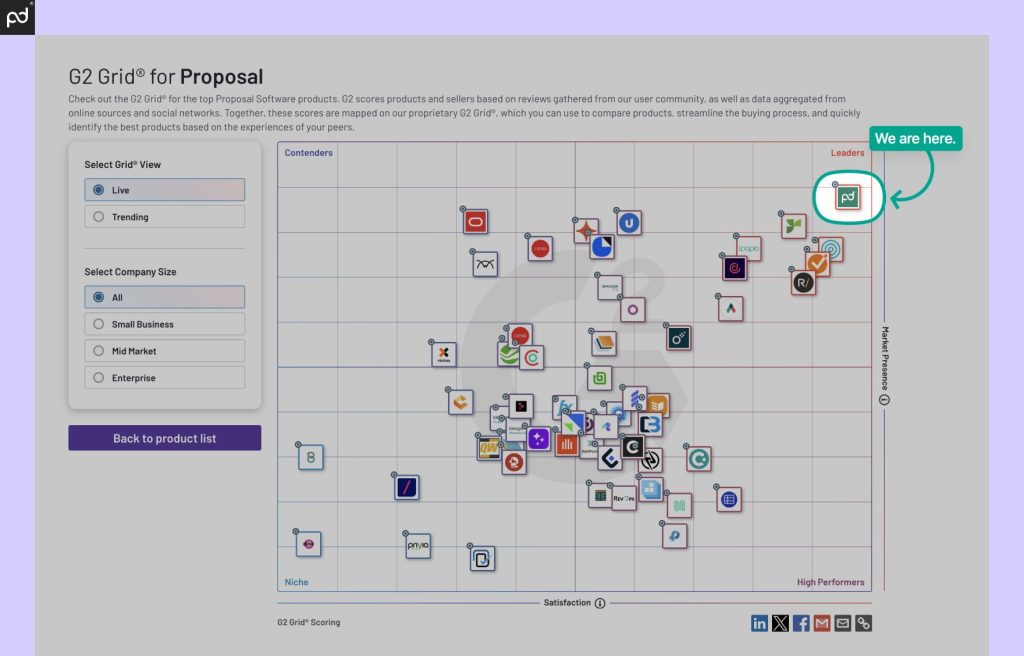
Choosing the right software
To curate this list, we leaned heavily on the G2 Grid for proposal software, as well as our own industry experience as leaders in the space.
Our team focused on the following criteria:
- Use case.
- Functionality.
- Affordability.
- Ease of use.
- Free trials.
For this article, we specifically focused on solutions designed for proposal and quote creation rather than RFP response software, which often caters to larger enterprises.
Lastly, we prioritized platforms that offered free trials, giving you the opportunity to test drive any software solution before committing to a purchase.
Happy reading!
1. PandaDoc
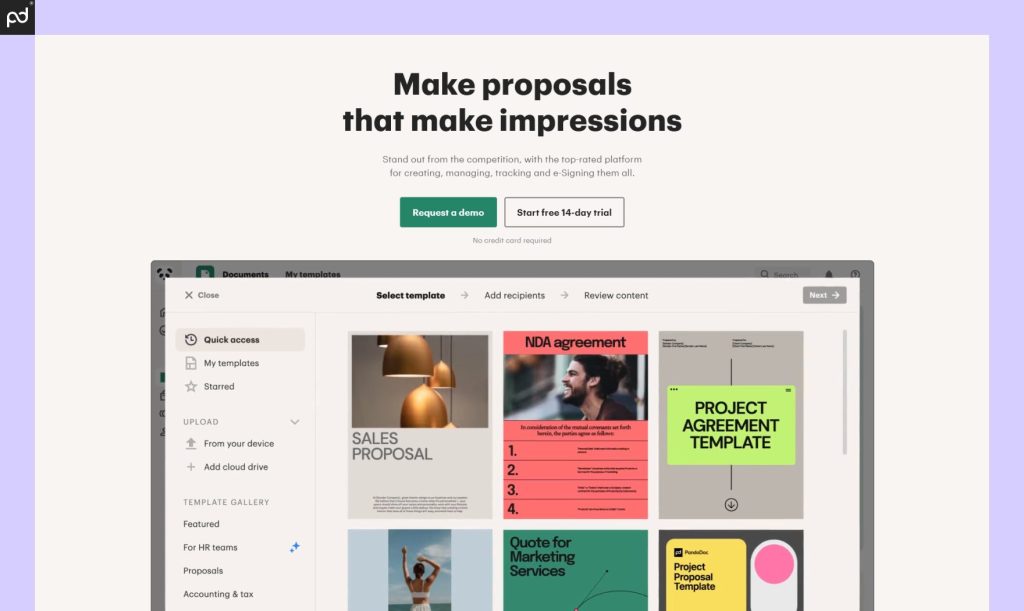
Powerful and user-friendly, PandaDoc is a proposal software platform designed to streamline the creation, sending, tracking, and management of professional proposals, contracts, and other business documents.
By leveraging PandaDoc, businesses can save time, reduce errors, and improve the quality of their documents and proposals.
The software is equipped with a huge selection of features to help businesses automate document workflows, collaborate with internal and external partners, and close deals fast.
Features include a drag-and-drop document editor, a robust template library, document management tools, and much more.
On top of that, PandaDoc offers a selection of integrations, including connections to Stripe, Salesforce, HubSpot, Pipedrive, and many others.
These connectors allow your proposal management software to talk with other key platforms in your sales pipeline, including CRM, productivity, and payment solutions.
All PandaDoc documents, including proposals, are built using the PandaDoc document editor, a drag-and-drop workspace.
Inside, users can build content in real time using powerful text and formatting tools. Proposal templates can even be saved afterward so that duplication and modification are fast and easy.
Once the proposal creation process is complete, you’ll be able to send documents to approvers for final signoff before dispatching them to prospective clients.
Have customers sign using electronic signature tools, and the final document can be stored permanently within the PandaDoc platform.
To save time and expedite the sales cycle, PandaDoc offers a variety of proposal automation tools.
This includes everything from a content library and customizable templates to automatic follow-ups and notifications to push deals along.
It’s a game-changer for businesses looking to streamline their document workflow and boost their sales success.
Platform highlights
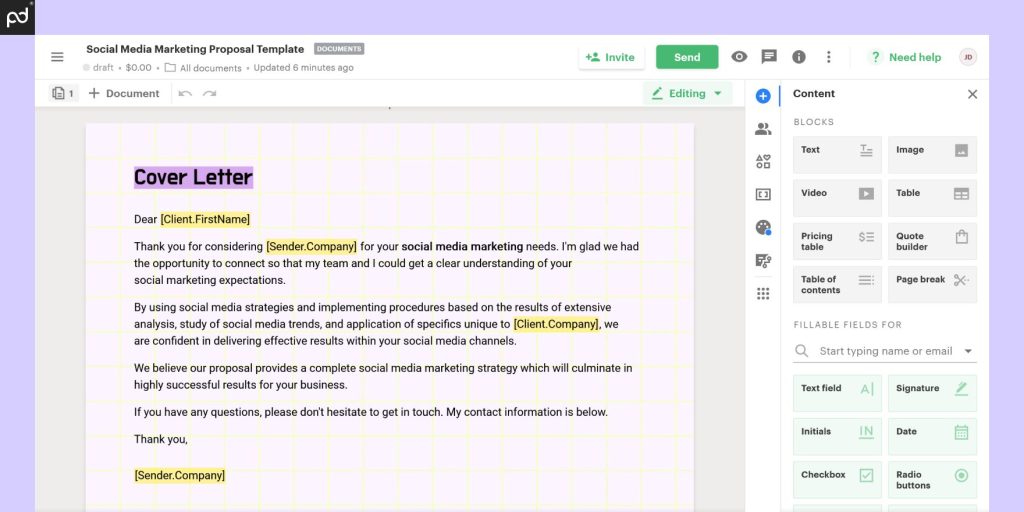
- Document editor. The onboard, from-scratch document editor enables users to build proposals, contracts, case studies, and other documents using intuitive, drag-and-drop tools. Text can be combined with electronic signing tools and multimedia in a user-friendly way to create stunning documentation.
- Content library. The PandaDoc content library allows users to save formats, layouts, text blocks, and multimedia snippets for reuse across multiple separate documents.
Important details
- Great for: Small and medium businesses who want to centralize document creation and management into a single platform.
- Price: From $19 per month.
- Free trial: 14 days.
2. Proposify
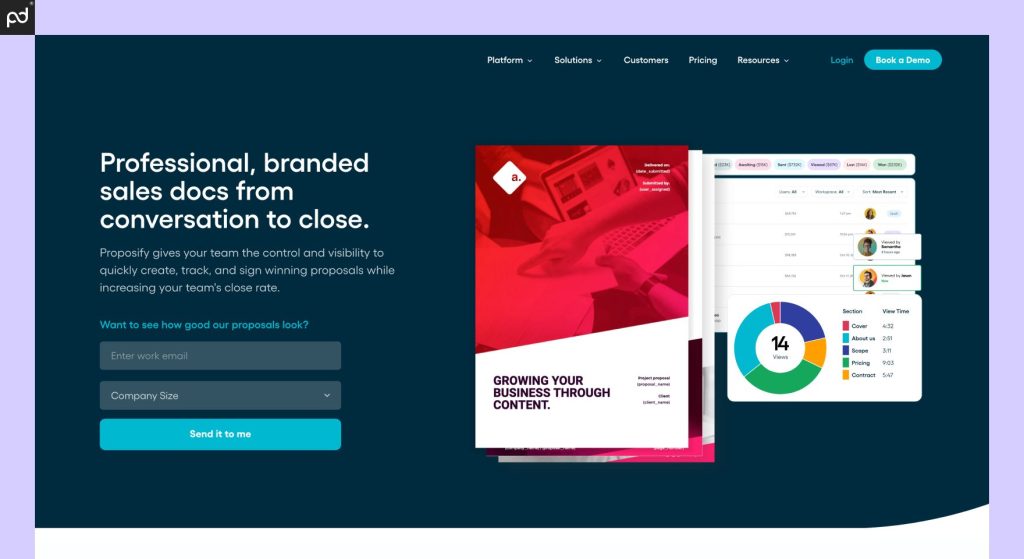
In many ways, Proposify is similar to PandaDoc.
This platform is a proposal automation software built around simplifying and enhancing the creation of proposals, contracts, quotes, and other sales documentation.
Proposify sports a user-friendly document editor that enables hands-on document creation without relying on tools like Microsoft Word or Google Docs.
Unfortunately, this comes with a few caveats.
Where PandaDoc and other proposal tools allow for easy importing/conversion of DOCX and other file types, you’ll need to rebuild your proposals entirely from scratch inside the Proposify editor.
Aside from that drawback, the documents produced within the Proposify editor can be visually stunning.
Aside from intuitive document design, Proposify also offers collaboration features that allow teams to work together while building proposals.
While not as robust as a competitor like QuoteWerks for product management, the onboard product tools will be sufficient for most teams.
Users can track changes, leave comments, manage event versions, and more to ensure a streamlined proposal process.
Analytics and metrics are also a key component of this software, allowing you to gather insights into document performance that you can use to better understand your sales process.
That data can come in handy later on as you optimize your sales documents around formats and layouts that have been effective in the past.
(Quick note: PandaDoc can do all of the above, as well. Check out our comparison article.)
However, Proposify does limit the number of times that documents can be opened each month — and those drawbacks are rather strict. Users on the Basic plan are restricted to five document opens/month while the Team plan only enjoys 30 opens/month.
For teams sending even a moderate amount of proposals, such intense restrictions can easily become a stranglehold on the entire sales operation.
If you can look past that caveat and you’re looking for a design-focused proposal solution, Proposify might be a good fit over turnkey solutions like Bidsketch.
The company even offers (paid) hands-on help, onboarding, and professional proposal design solutions so that you can maximize the visual prowess of your sales documents in record time.
Platform highlights
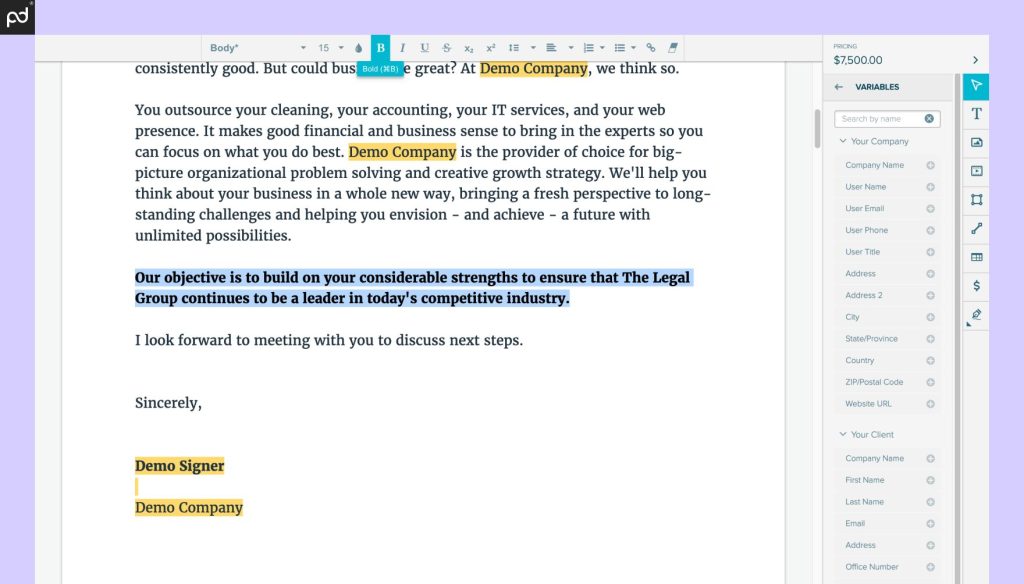
- User-friendly document editor. Proposify makes it easy to create visually stunning documents without the need for a design background or an art degree.
- Expert-level customization. Want to have an expert create an eye-catching design so that your team only needs to fill in the blanks? Proposify offers design and training services with a high level of customization and support.
Important details
- Great for: Small businesses who want to build high-quality proposals using a robust suite of design tools.
- Price: From $29 per month.
- Free trial: 14 days.
3. Bidsketch
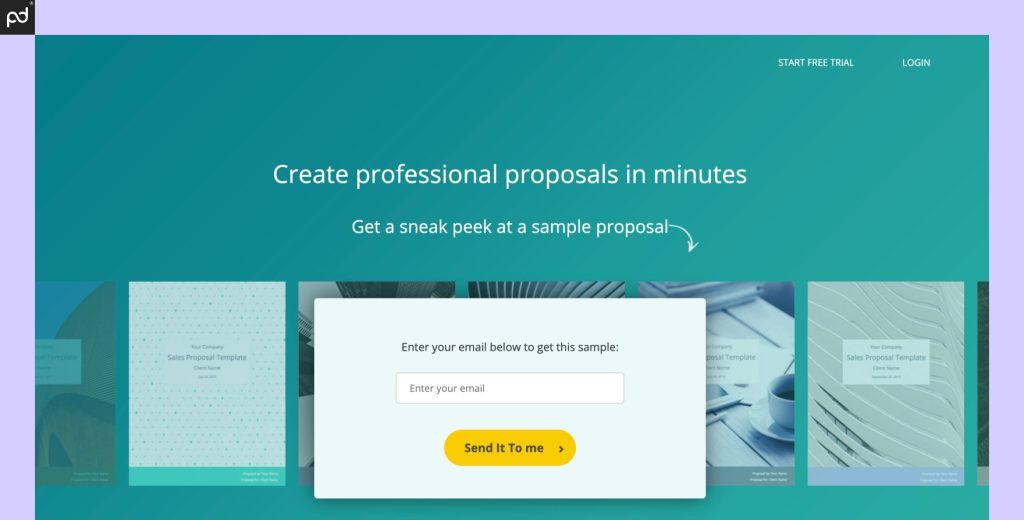
Bidsketch is a proposal platform designed to simplify the proposal process through intuitive design and a user-friendly interface.
Unlike PandaDoc and Proposify (above) Bidsketch doesn’t offer a live-editing environment during proposal construction.
Instead, the platform breaks proposals down into three sections — Opening, Fees, and Closing — and encourages users to add a series of pre-arranged text blocks to each section.
The blocks needed to fill each section can be created from scratch or can be drawn from Bidsketch’s extensive template library.
However you choose to do it, the ultimate goal is to make the nuts and bolts of the proposal process as modular and simple as possible.
Although this process might seem foreign at first glance, it’s no different from using pre-built templates or a content library within other, competitive tools.
For example, the PandaDoc content library helps users create snippets and blocks of content that can be recycled and reused across multiple documents.
Bidsketch leverages that concept more heavily by pushing users to create those content blocks first and then use them to compile proposals as quickly as possible.
It’s a clever system, and one executed at a very high level.
However, this approach isn’t without downsides. As we’ve mentioned, Bidsketch lacks a live editing environment.
Instead, the platform compiles all quotes into a pre-structured process. While you’ll be able to change the cover and some details, every quote and proposal generated by Bidsketch will look roughly the same.
For businesses who need to generate quotes in a hurry, that won’t be a concern.
Unfortunately, SMBs looking to leverage design to stand out from the crowd won’t have the flexibility here to make truly stunning proposal designs.
Further, while platforms like PandaDoc can be used for contracts, forms, HR documents, and more, Bidsketch’s structured approach to proposal generation means that the platform lacks the flexibility for a broader use case.
Platform highlights
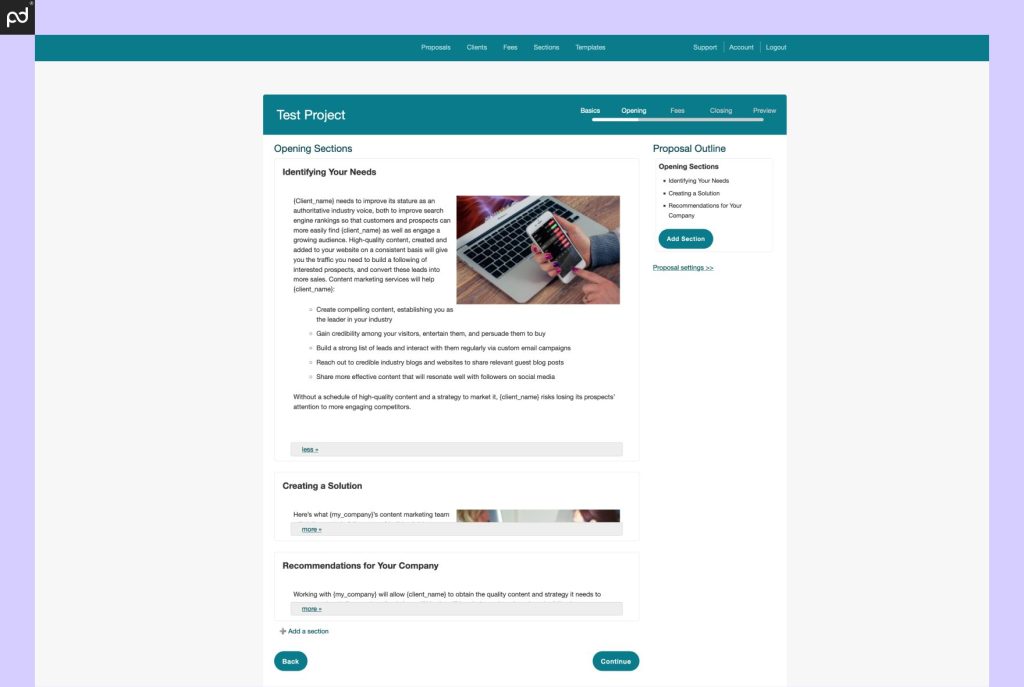
- Turnkey proposal creation. Bidsketch removes the guesswork around proposal design, enabling reps to snap relevant sections together into an acceptable proposal without worrying as much about formatting and layouts.
- Emphasis on content recycling. While other tools encourage reusing content with libraries and templates, Bidsketch’s entire platform is built around this idea.
Important details
- Great for: SMBs looking for fast, standardized proposal generation.
- Price: From $23 per month.
- Free trial: 14 days.
4. Qwilr
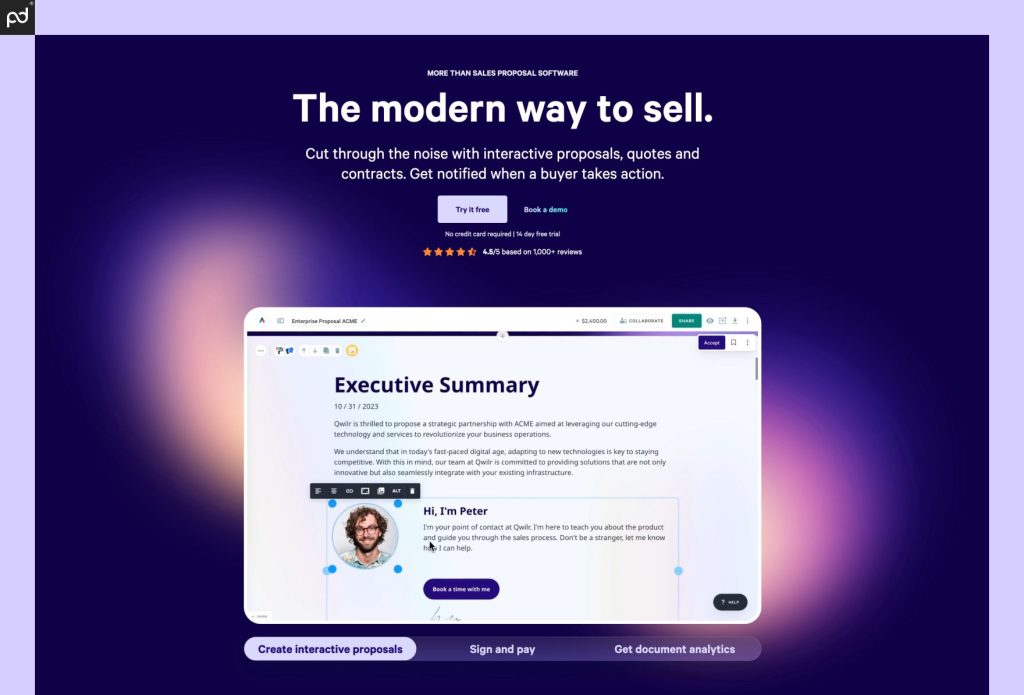
Most modern businesses operate in online environments all the time.
Sales and CPQ platforms are web-based. Data is stored in the cloud. Information is available with a click and a search.
So, why should you treat your sales proposals any other way?
Qwilr is designed to modernize your sales and proposal process by creating online proposal web pages that are interactive, expressive, and on-brand.
You can use multimedia, interactive pricing tables, set brand colors, add custom fonts, and more to build a proposal that has the look and feel that you want.
Each proposal with Qwilr is one interactive page.
However, you don’t need to be a web designer in order to build proposals in this format. Qwilr allows users to build web-pages using a collection of drag-and-drop tools that are easy and intuitive to understand.
The layouts are clean and simple, too, which sets Qwilr above similar web-based competitors. You won’t see dense, multi-page legalese here.
Every block and table is designed to look flashy and feel great.
That being said, it’s completely possible to overbuild or crowd a layout with too much text or with pricing tables that feel clunky and unintuitive. Some level of care (and design instinct) has to be take ensure that the information is arranged in a user-friendly way.
For small- to medium-sized businesses the Business plan will be the only real option.
This plan offers a healthy selection of features, but users will miss out on team permissions, template settings, and custom branding options.
Unfortunately, the next step up is the Enterprise plan, which requires a minimum of five users and costs nearly $60/month on an annual plan. It’s the only way to access CRMs like Salesforce and/or gain access to more comprehensive customization features.
Platform highlights
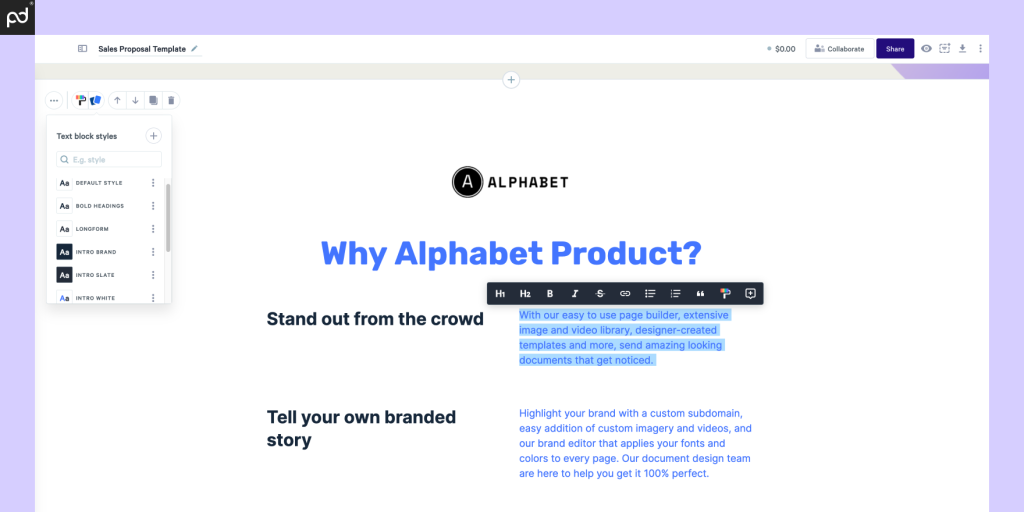
- Plug-and-play design. Qwilr’s editor is a cross between a web-design tool and a word processor. If you’re looking for a no-code design tool with plenty of power under the hood, this editor is one to note.
- One-click automation. Similar to PandaDoc templates, Qwilr allows for streamlined proposal generation using templates. This allows reps to speed up sales processes and get deals out the door without needing to hand-craft personalized sales documents.
Important details
- Great for: Teams who want non-traditional proposals that offer a sleek look and unique feel.
- Price: From $35 per month.
- Free trial: 14 days.
5. Anchor
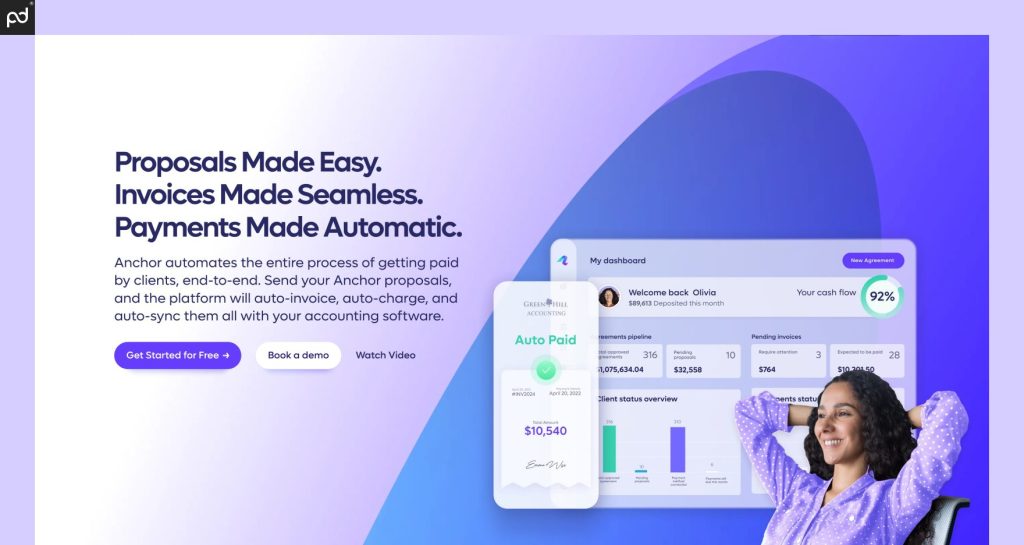
Of all the proposal platforms on our list, Anchor is one of the most unique in its approach to document creation and billing.
Let’s start with billing: Anchor charges users $5 per payment received through the platform. That’s it. No monthly fees; no annual commitments. Just $5 per payment.
Depending on the nature of your business, that might be a great deal or a terrible solution. Companies with several small invoices may find that a traditional plan with a monthly commitment is more useful, while organizations with only a handful of clients (or those billing quarterly rather than monthly) may see a clear advantage with Anchor.
Anchor’s proposal generation process is also unique.
The entire platform is built around autonomous billing and is designed to minimize the need for companies to chase payments.
(Quick note: You can do this at PandaDoc with recurring payments!)
Clients insert their payment information before work ever begins. This creates a “live agreement” that automatically generates invoices upon completion of service, saving time and hassle. Although the agreements are automated, they can be updated to more accurately reflect the work being done or modified entirely to encapsulate new projects and scopes of work.
The platform’s overarching goal is to minimize the time and effort that companies need to spend trying to get paid and allow them to put that energy toward generating additional revenue.
With all of that said, there are a few downsides to Anchor’s approach.
First, while it’s possible to generate some introductory text, Anchor is more heavily focused on billing and less on proposal creation.
The platform assumes that you’ve worked out some of the details with a client and are able to assemble those details into a workable proposal with a dedicated package.
Second, the packages themselves are clearly geared toward recurring services.
Anchor is heavily focused toward ongoing subscriptions — which is ironic, considering that they charge by payments received!
The downside is that Anchor doesn’t have much to offer organizations focused on one-off jobs or milestone-based projects.
It’s possible to handle those items using Anchor’s live agreements, but it’s not a simple “set it and forget it” approach.
Lastly, while Anchor’s approach may work for B2B relationships at the smaller scale, it may not scale as well when organizations have a dedicated billing department where inserting payment cards and automating the invoicing process may work against the finance team, who oten prefers manual payment authorizations and traditional invoices.
While it’s possible to work around many of these roadblocks, it’s worth noting that teams working with Anchor may end up needing alternate proposal and invoicing solutions to manage clients who can’t be onboarded to the system.
Platform highlights
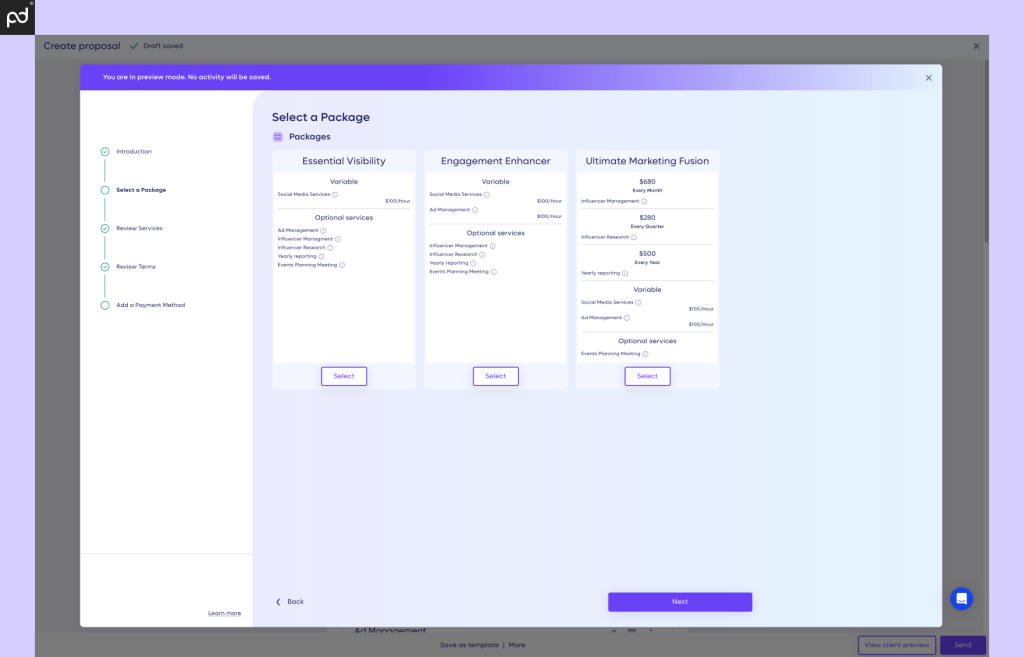
- Autonomous payments and live agreements. Anchor helps users automate the billing process by creating “live agreements” that can be further modified to match an evolving scope of work.
- No monthly fees. Because Anchor charges on a per payment basis, this platform has eliminated monthly fees and subscriptions. You pay when you get paid. It’s that simple.
Important details
- Great for: Companies with recurring, packageable service offerings that can be easily offered to clients.
- Price: $5 per payment.
- Free trial: N/A. Anchor is always free to use.
6. Quotient
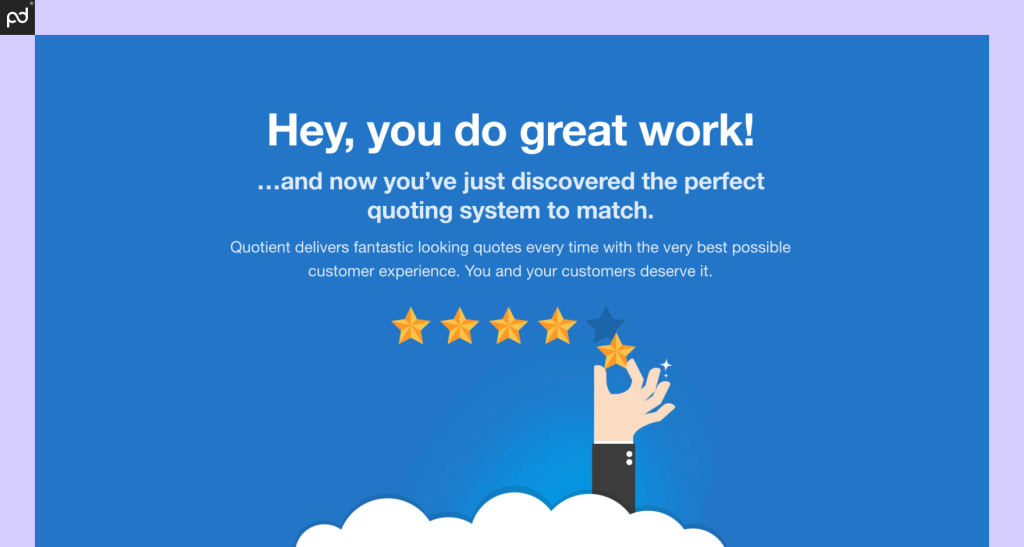
Unlike many of the tools on our list, Quotient is primarily geared toward quote generation for freelancers and small- to medium-sized businesses.
This platform lacks some of the more robust design options that you might see in more complex software, but the tradeoff comes from the ease of use and the consistency of output.
In many ways, Quotient is an example of a software tool that does one thing well. In terms of output, all quotes and proposals follow roughly the same format.
While you’ll still have some customization options around branding and content, the overall document structure will be the same when using this tool.
It’s possible to add text and additional information about a given project, but the detailed pricing breakdown that the software provides is at the core of its generation process.
You’ll be able to list multiple different sales options and allow customers to select the best fit for them.
On top of that, customers can ask questions and leave comments directly on the quote.
That correspondence is something that is publicly visible, so any other reviewers with a similar question will be able to see what was asked and what changes were made.
Overall, while Quotient isn’t as flashy as some of the other software tools, it’s still a solid option for producing excellent quotes.
Particularly on the business plan, which includes between two and five team members, it’s also one of the most affordable multi-user quoting options that we’ve encountered.
Platform highlights
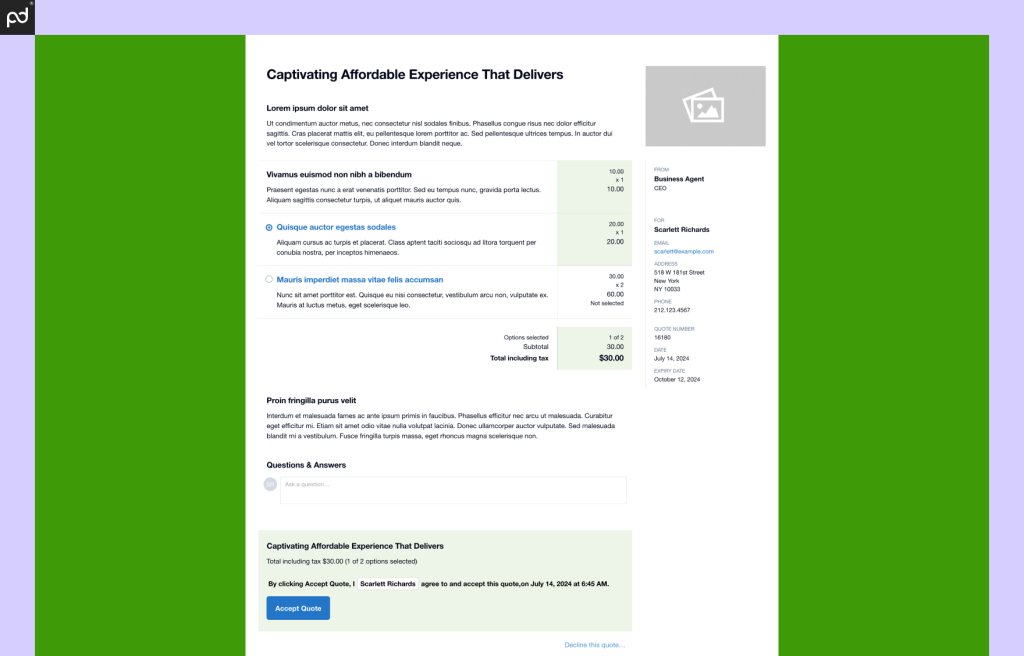
- Simple, logical quote design. Quotient sales proposals and quotes are built primarily around a pricing table and a few simple content modules. The design is simple compared to other quoting tools, but the output will be serviceable for many small- to mid-sized businesses.
- Low-cost, multi-user plans. If you’re looking for a budget-friendly option, Quotient is one of the only platforms we’ve seen that offers a multi-user plan without stepping into enterprise-level pricing. The Business Time plan costs $48/month and automatically includes between two and five users.
Important details
- Great for: Freelancers and smaller organizations who need to generate quotes consistently and quickly.
- Price: From $28 per month.
- Free trial: 14 days.
7. Oneflow
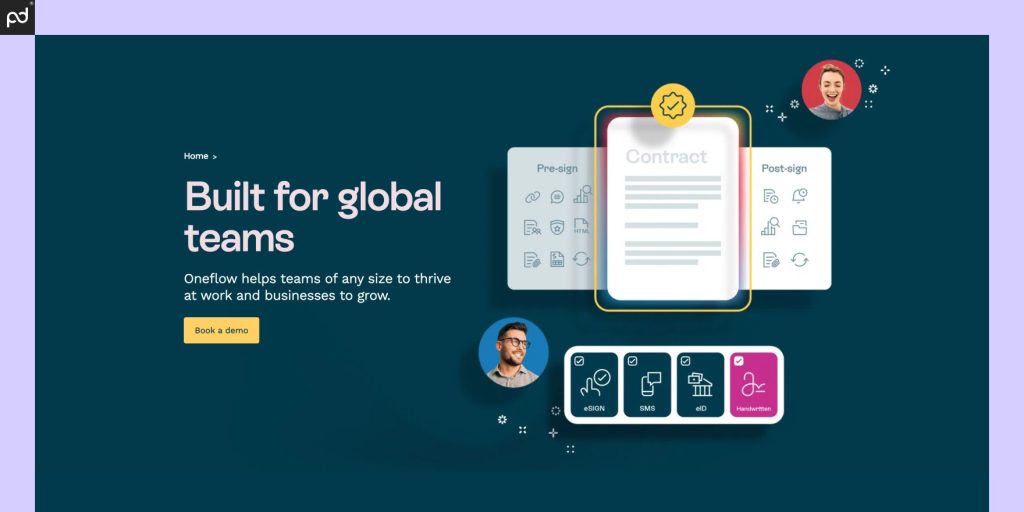
Oneflow is a contract automation platform with over a decade of experience under its belt.
This platform focuses heavily on contract lifecycle management (CLM) processes, including the creation, negotiation, signing, and management of contracts.
However, the toolkit that Oneflow provides can easily be used to generate and manage stunning sales proposals.
Like Proposify and PandaDoc, Oneflow offers a live editing environment.
Users can create documentation entirely from scratch or insert pre-built / pre-approved language via templates and data fields.
Oneflow also wants to keep the entire negotiation and collaboration process inside the document.
While the service doesn’t offer virtual deal rooms like you’ll see with PandaDoc or GetAccept, collaborative tools include inline comments, approval workflows, and screen recording.
You’ll also find a robust and compliant e-signature protocol (as well as audit trails and tracking) to validate the authenticity of signed contracts for legal purposes.
However, while Oneflow is a formidable contracting tool, it varies from the other solutions on our list in that it focuses more on contracts than on proposal generation.
The platform’s strong focus on data security and compliance — as well as pricing tables, when used for proposal and quote generation — allows Oneflow to thrive during the CLM process.
In many ways, this approach makes Oneflow a similar contrast to Proposify, which is primarily focused on proposal generation but can also handle other document types when pushed into the niche.
Oneflow’s specialized focus and features on CLM make it a good option for organizations that primarily need those contracting tools (with a few proposals in between).
For SMBs looking for additional platform versatility, PandaDoc is likely to be a better fit.
Platform highlights
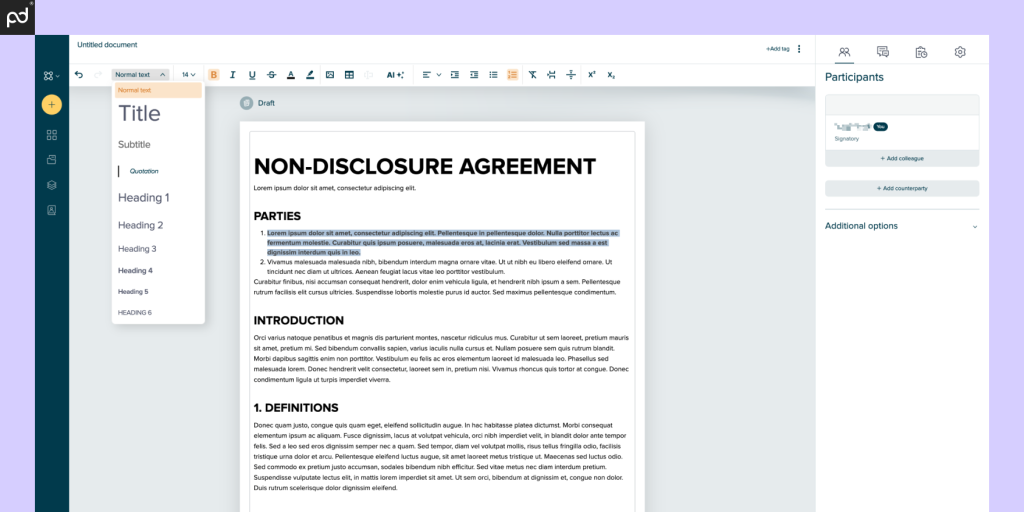
- Robust CLM tools. Oneflow offers tools to streamline contract lifecycle management processes and workflows. This can help SMBs better manage contracts and agreements (not just proposals!) for their entire lifespan.
- End-to-end contracting. Teams who want to centralize their contracting process can handle everything with Oneflow. The platform offers live document creation, negotiation and collaboration, and e-signing for contract finalization — all in one place.
Important details
- Great for: Organizations with a heavy focus on contracts — including, but not limited to, sales proposals.
- Price: From $17 per month.
- Free trial: 14 days.
8. Fresh Proposals
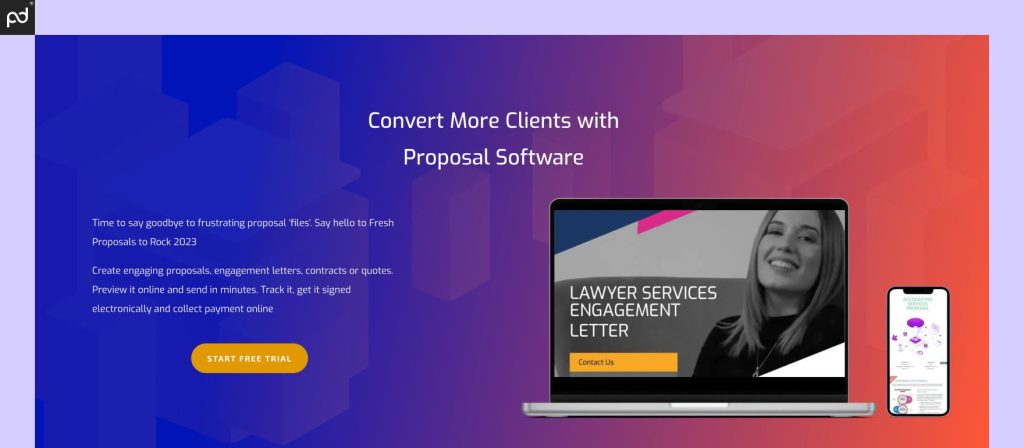
Fresh Proposals is a comprehensive proposal solution designed to streamline the creation, delivery, and tracking of professional proposals.
Similar to dedicated tools like Bidsketch and Proposify, Fresh Proposals is focused solely on proposals and offers a robust toolkit dedicated entirely to that purpose.
The platform features a selection of pre-built, customizable templates (similar to the PandaDoc template library), many of which are catered specifically to various industries and services. These serve as a great starting point for teams who need to quickly craft visually appealing proposals that still feel on-brand.
As with other competitors in the space, Fresh Proposals offers a live editing environment where users can customize text and personalize specific passages.
While the Fresh Proposals editor lacks the nuance and fidelity that you’ll see in Proposify, it’s more than enough to get the job done in most scenarios.
Beyond proposal creation, Fresh Proposals offers solutions for the rest of the proposal process. This includes payment gateways, e-signing functionality, custom email domains, and more.
It’s everything that a freelancer or smaller organization will need to start sending great proposals in short order.
In terms of downsides, there are a few factors to consider.
As previously mentioned, Fresh Proposals is focused on proposals. While not inherently a bad thing, it does relegate this platform to a niche use case.
That’s particularly true when measured against competitors like PandaDoc, which can be used for a variety of different use cases, including contracts, invoices, and forms.
Additionally, similar to Bidsketch, Fresh Proposals also uses pre-set templates for the majority of its outputs.
While various design options and layouts are available, the editor lacks the versatility that you’ll see in something like Proposify, where users have near-total control over the final output.
Ultimately, this platform is a strong contender for proposal generation and will be a great fit for teams looking for a low-cost, niche-focused solution.
Platform highlights
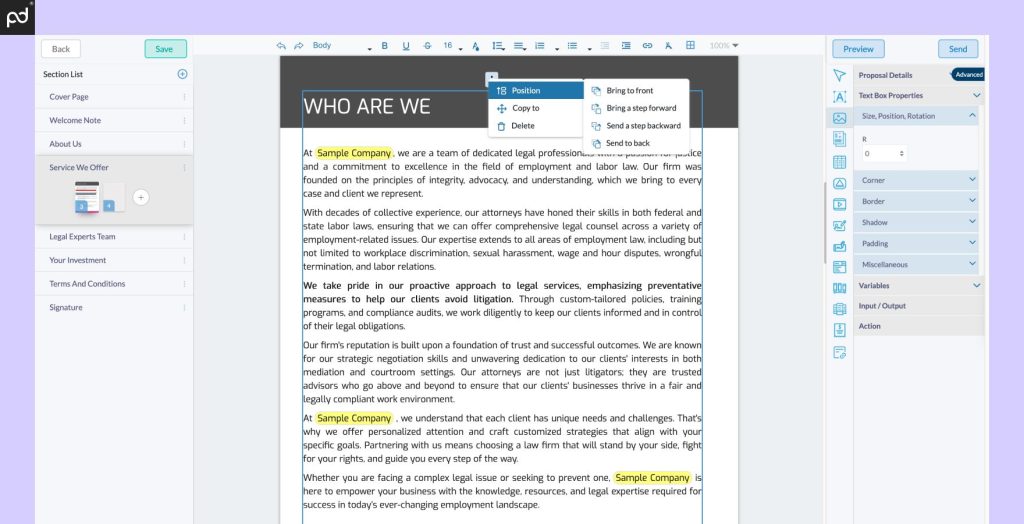
- Dedicated proposal creation. This platform is focused entirely on proposal creation and executes at a high level, but it lacks the flexibility to handle other use cases well.
- A balanced approach. For many, Fresh Proposals strikes the ideal balance between control and streamlining during the proposal creation process. The platform provides a decent level of control without overwhelming users.
Important details
- Great for: Teams looking for an ideal balance between design and automation for their proposal process.
- Price: From $20 per month.
- Free trial: 14 days.
9. Ignition

As a proposal software tool, Ignition is designed to help you get comprehensive sales proposals out the door quickly and with little guesswork.
Although template customization is possible on higher levels, the meat of this platform is in document generation, meaning that companies input information and the proposal builder returns a pre-formatted proposal that is ready to send.
At higher tiers, the standard proposal layout can be customized somewhat. However, any document generation tool (not just Ignition) will make a clear distinction between the design process and the input process.
By divorcing the two from one another, the platform creates a scenario where teams only need to focus on the quality of the input while the look and feel of the final product is predetermined.
(Note: Ignition isn’t the only tool on our list to take this approach. Bidsketch, Quotient, and Anchor all opt for this route as the primary form of document creation.)
This approach might seem reductive if you’re used to having total control over the look and feel of the proposal — something that we wholeheartedly endorse via our live editing platform at PandaDoc — but it does have some merits.
Similar to the way that PandaDoc allows for content locking and the use of pre-assigned templates to create a consistent look and feel across a brand, Ignition creates a workflow that is approachable and easy for reps to use.
The result? Great-looking proposals with a high degree of consistency and accuracy.
This approach also doesn’t exclude Ignition from offering useful customizations.
Modules like pricing tables still allow for upselling opportunities. Multimedia embeds still have a place.
While the approach is more controlled, Ignition still offers end-to-end document processes — all the way from document creation to e-signing and payment collection.
Platform highlights
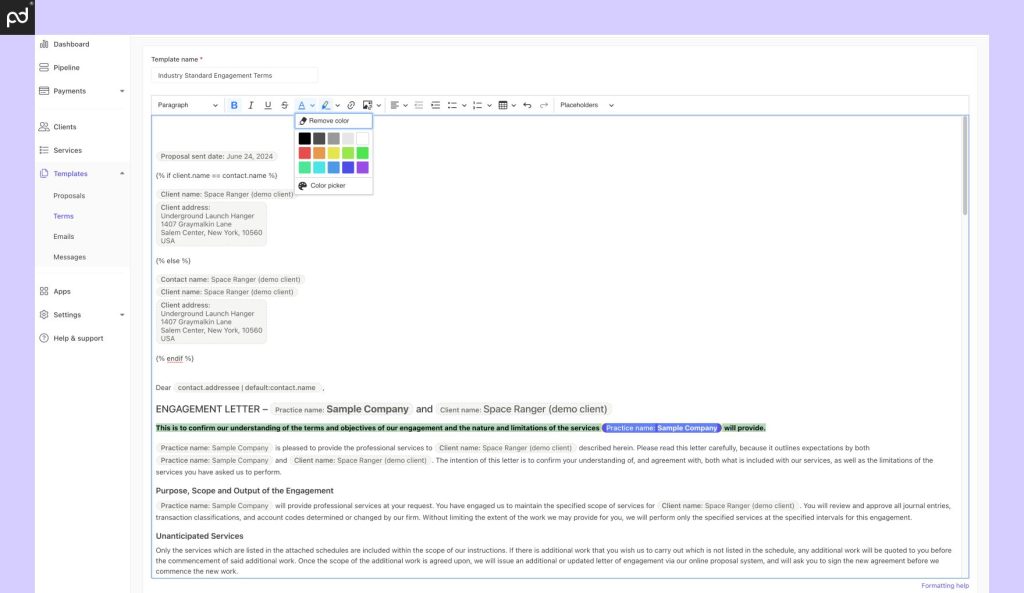
- Document generation. Ignition uses document generation workflows (rather than from-scratch document creation) to build its documents. This limits the amount of customization available to a rep but greatly improves output consistency.
- Engagement letters. A unique feature, Ignition’s automated engagement letters sum up your services, pricing, billing frequency, and more in one place so that potential clients have a summary of terms and an easy way to sign up.
Important details
- Great for: Mid-sized organizations who prefer set-it-and-forget-it proposal layouts and streamlined proposal workflows.
- Price: From $99 per month.
- Free trial: 14 days.
10. GetAccept
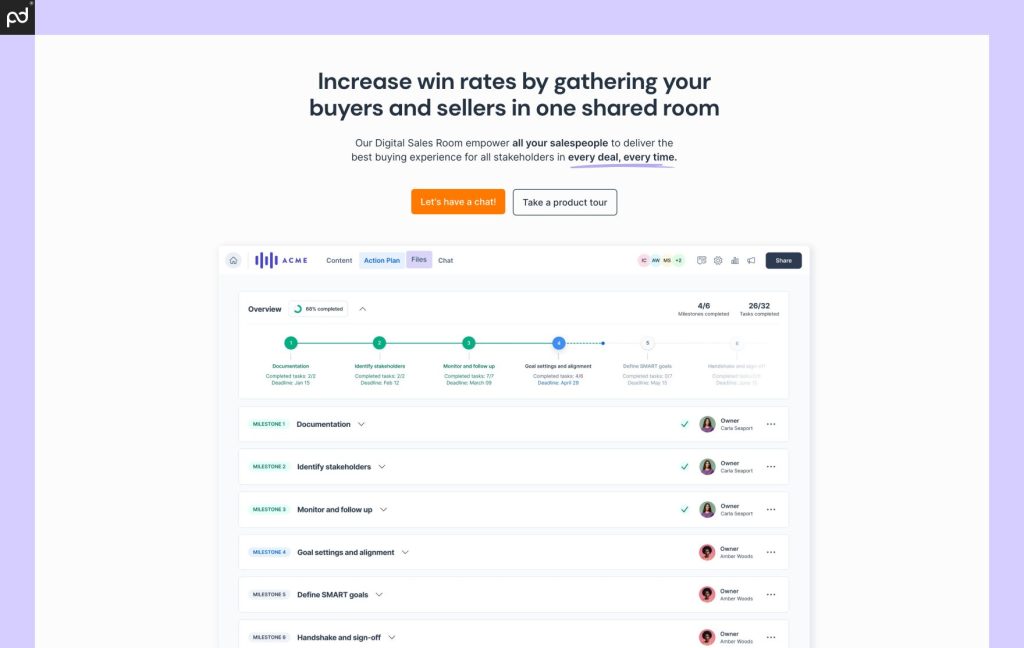
The GetAccept platform offers tools and features that go beyond sales proposals.
On top of helping you create any sales documentation you might need, GetAccept offers deal rooms (just like PandaDoc) and engagement tools to facilitate a smooth, interactive selling process between customers and reps.
At the same time, GetAccept aims to prevent any one team member from being a champion by providing collaboration tools that bring all stakeholders together in a deal.
This allows multiple team members to stay on top of negotiations and client interaction within a controlled environment.
The result? Collaborative, group-based selling that allows everyone to work together to push a deal forward.
GetAccept also comes with an in-house document editor that you can use to create from-scratch documents (something that puts it a head and shoulders above simple e-signing platforms like DocuSign).
You can also upload your own templates and prebuilt files.
While this editor isn’t as robust as some of the others on our list, it’s more than enough to build customizable quotes and get them out the door.
From the perspective of automation, GetAccept is chock-full of integrations, templates, and similar tools to expedite your sales process.
You’ll also have access to document insights and analytics to better track client interactions so that you can optimize future deal templates.
Platform highlights
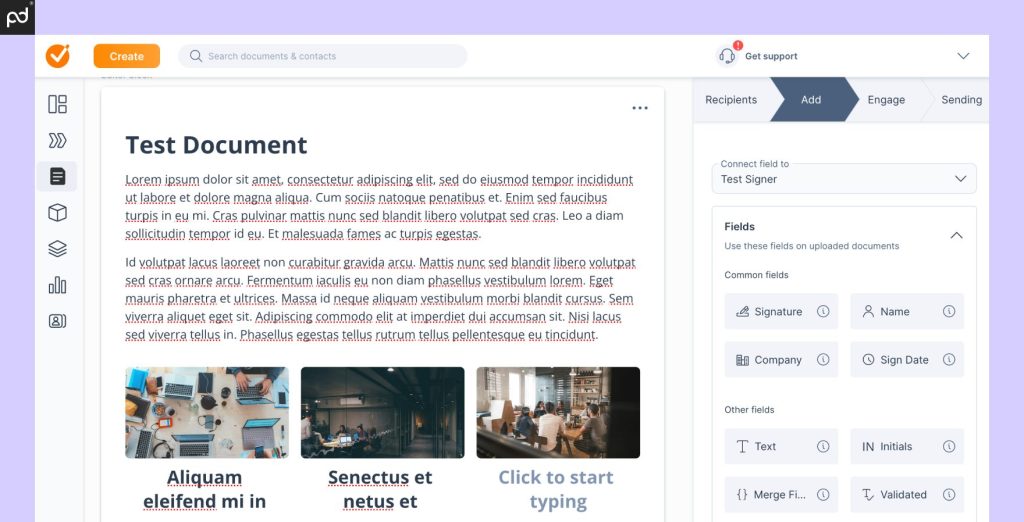
- Group-focused selling tools. GetAccept offers a huge number of group-focused tools. This includes deal rooms, group chat functionality, collaborative in-app editing, and more. The entire goal of the platform is to humanize sales and turn the selling process into a team effort.
- Robust engagement tools. By leveraging deal rooms and other collaborative tools, it’s clear that GetAccept wants to be more involved in your sales process than a traditional proposal tool. If you’re looking for a sales platform that offers a variety of engagement options, GetAccept is a top choice.
Important details
- Great for: Sales-focused organizations looking for collaborative sales flows.
- Price: From $39 per month. (The $25/month plan is e-sign only.)
- Free trial: 14 days.
Ultimate recommendation: PandaDoc!
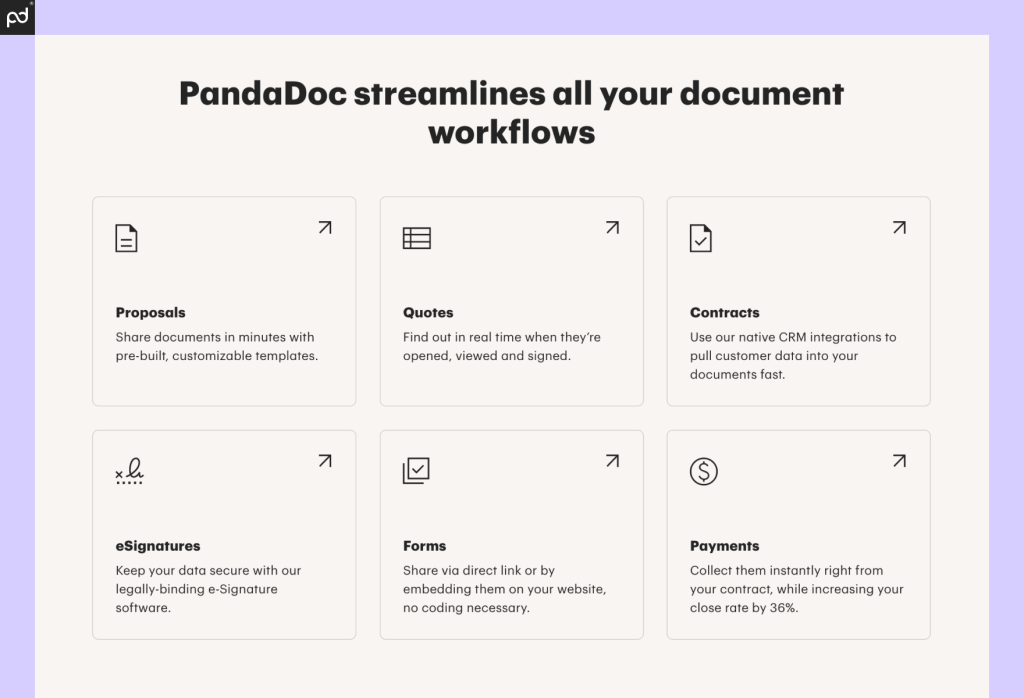
If you’re asking for the best proposal software for small businesses, it’s got to be PandaDoc.
(We know, we’re a little biased, but hear us out.)
PandaDoc is one of the only sales platforms that offer a comprehensive set of proposal management tools — including payment collection, a mobile app, in-app document editing, and more — inside a platform that can scale and grow with your business.
If you’re looking for an all-in-one solution that can help you create and manage your sales proposals, quotes, contracts, and invoices, PandaDoc is one of the best platforms on the market.
You don’t even have to take our word for it.
Sign up for a free demo, or test drive everything yourself with a free 14-day trial.
We know you’ll love it.
Disclaimer
Parties other than PandaDoc may provide products, services, recommendations, or views on PandaDoc’s site (“Third Party Materials”). PandaDoc is not responsible for examining or evaluating such Third Party Materials and does not provide any warranties relating to the Third Party Materials. Links to such Third Party Materials are for your convenience and do not constitute an endorsement of such Third Party Materials.
Originally published October 4, 2019, updated August 19, 2024
Frequently asked questions
-
Yes. All platforms on our list will provide assistance when creating sales proposals. Many of these tools can even help by to clarify what information your proposal might need.
For example, at PandaDoc, we offer preset templates to help users determine what they should put in their proposals. Other companies offer similar features. If you’re unfamiliar with what should go into your proposal, check out a template or do a little extra reading on how to write a winning sales proposal.
At the same time, it’s worth pointing out that some of the tools on our list lean more heavily into quote generation, minimizing the amount of text required in favor of itemized breakdowns that can define a workable proposal.
-
It’s critical.
In most scenarios, a proposal isn’t a guarantee of income. It’s entirely possible for a business to spend time writing a detailed proposal only to be outbid by a competitor or have a client go in another direction.
When that happens, a business loses money due to time investment. Automation tools are essential in proposal software because they can help users do more in less time and minimize the losses incurred when a deal falls through.
Rather than building a new proposal entirely from scratch every time an opportunity materializes, solutions like template generation and content libraries make it easy to recycle information between opportunities.
This allows teams to create documentation much more quickly while reducing administrative processes. Many companies leverage that extra time to pursue additional sales opportunities in hopes of winning more work.
-
The precise integrations you need will depend on your tech stack. For example, if you’re not using Salesforce as your CRM, a Salesforce integration probably won’t offer much of a benefit to you.
Typically, you’ll want to find integrations that make sense for your organizational needs.
- CRM integrations can help you better manage your customer accounts by importing customer data directly to your proposals.
- Productivity integrations like those for Slack or Zoom can help you share content more effectively.
- Payment integrations (Stripe, Paypal, etc.) can help you capture payments more quickly.
Keep in mind that, for integrations to work, two software platforms need to be able to talk with one another. Sometimes, you’ll find a native integration for this, like the PandaDoc x Salesforce integration.
Other times, you’ll need to go through a third party tool like Zapier to make that connection (additional fees apply).
You can probably avoid integrations that your platform manages internally. For example, most proposal tracking software is included in modern platforms, so you shouldn’t need extra tools to handle that aspect of proposal management.
-
In many ways, request for proposal (RFP) response is a subcategory of proposal generation. Organizations that distribute RFPs are looking for responses that meet predetermined criteria. They’re essentially inviting companies to bid on a job to better understand how a company might do it.
Often, this is done with minimal face-to-face interaction. The organization posts the RFP, invites users to apply, then waits for the proposals to come in so that they can review them and select the right candidate for next steps.
It’s similar in many ways to a hiring process.
That’s much different from a standard sales process, where customers interact with sales reps and negotiate contracts before moving forward with proposed work.
Because of how the RFP process works, companies bidding on RFPs need to fill out proposal requests quickly — something that becomes very tedious and repetitive — so RFP response tools are designed around automating these processes to help companies place more bids in less time.
However, most tools inside an RFP response software won’t be useful to teams building traditional sales proposals.
-
Most (not all!) proposal software platforms offer some kind of document building. Typically, this is broken down into two basic types:
- Document editors allow users to manipulate text and layouts using an intuitive interface. They’re often similar to a word processor. You can use drag-and-drop tools, format text, and customize the look and feel of your documents.
- Document generators separate the content input and design output. With a generator, you’ll determine what design layout you want first. This is typically done at the administrative level. Sales reps will input their text into a series of boxes or windows (or using a similar preset workflow) and click a button. The generator will then add the text to the template and produce a finished design.
While one option isn’t inherently better than the other (although we offer a document builder at PandaDoc), most proposal softwares use one of these workflows to provide a proposal for your use.
Generally, document generators work well as proposal software for consultants and freelancers since they keep the amount of document inputs to a minimum. However, small organizations who want to stand out from the crowd should consider document editors instead.
For example, if your team generates documents exclusively in Microsoft Word and you need them to be signed, an dedicated e-signing platform might be a better fit for your needs.

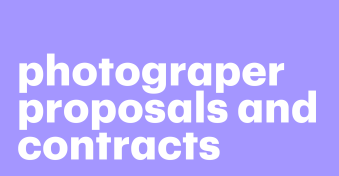
![[Research] 5 ways to increase the close rate of your proposal](https://public-site.marketing.pandadoc-static.com/app/uploads/sites/3/Cover_5-surprising-data-points-to-close-proposals-fast_opt-1-1-339x176.jpg)